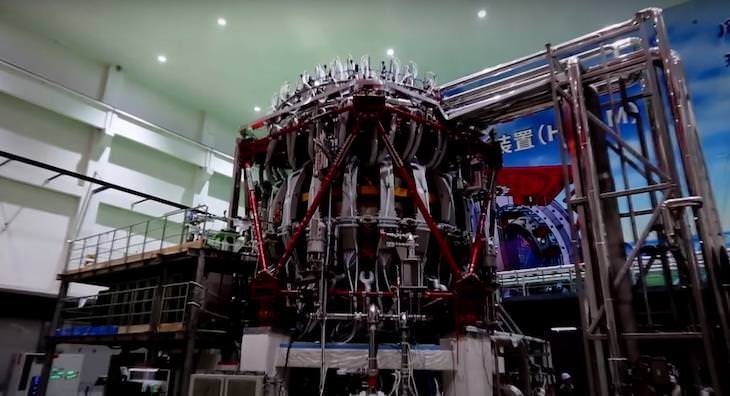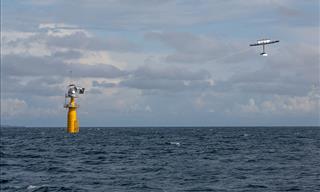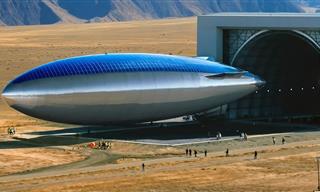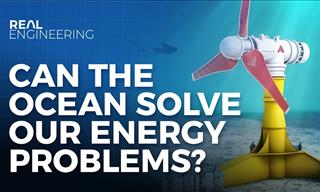
According to media reports from the past weekend, China’s “artificial sun” nuclear fusion reactor, called HL-2M Tokamak, was powered up successfully for the first time. This development is significant as it could revolutionize the way we produce and consume energy.
The reactor uses a powerful magnetic field to fuse hot plasma and can currently reach temperatures of over 280 million degrees Fahrenheit (150 million degrees Celsius). To get some perspective, this temperature is approximately ten times hotter than the core of the sun, hence the nickname 'artificial sun’.
"The development of nuclear fusion energy is not only a way to solve China's strategic energy needs, but also has great significance for the future sustainable development of China's energy and national economy," according to the statement given by the team to People's Daily. In other words, the HL-2M Tokamak could potentially be a powerful and much-needed clean energy source.
The way fusion works is by merging atomic nuclei to create massive amounts of energy - the opposite of the fission process used in atomic weapons and nuclear power plants, which split them into fragments. Unlike fission, fusion emits no greenhouse gases and carries less risk of accidents or the theft of atomic material.
Chinese scientists have been at work on this project since 2006. The plan is to use the device in collaboration with the International Thermonuclear Experimental Reactor (ITER) - the world's largest nuclear fusion research project based in southern France, which is expected to be completed in 2025, and its total cost is estimated to be a whopping $22.5 billion.
Related: 16 Random and Interesting Facts About Nuclear Power

HL-2M Tokamak Image source: YouTube
There are 25 nations overall collaborating in the work on ITER. The goal is to build a device designed to prove the practicality and usefulness of fusion as a carbon-free source of energy based on the same principle that powers our Sun and stars.
"ITER will be the first fusion device to maintain fusion for long periods of time. And ITER will be the first fusion device to test the integrated technologies, materials, and physics regimes necessary for the commercial production of fusion-based electricity," writes the project's website.
Time will tell whether nuclear fusion becomes a viable and affordable source of energy production, but China’s recent achievement with HL-2M Tokamak and its forthcoming collaboration with ITER is certainly an important and fascinating step forward.
Cover image source: Interesting Engineering/ Chinese Academy of Sciences
Share this news with family and friends

The Future of Wind Power Can Be Shaped By This Energy Kite
Here is a look at the the fascinating new wind energy kites that can shape the future of wind power.

Even More Happy and Positive News From 2021
Turns out happy and positive things occur around the world all the time. Here are 13 happy news stories form 2021!

New Bionic Eye Developers Say It Will Cure Millions
Scientists are developing an artificial eye, that can potentially eliminate blindness and transform robotics!

These Science Comics Will Make You Laugh Out Loud
Ed Himelblau is a biology professor who also makes some seriously funny comics.

Scientists Find a Way to Convert Brainwaves Into Sentences
In a fascinating recent study, researchers managed to teach a machine to translate brainwaves into English sentences.
 20:01
20:01
Future Tech: 19 Innovations About to Change Our World
These groundbreaking new technologies will change our world.
 1:44
1:44
The Accidental Discovery of the World’s First Antibiotic
Not too long ago, it was fairly common to die of the simplest of wounds due to bacterial infection. Penicillin changed everything.
 7:15
7:15
Toilets: The Greatest Medical Advancement in Human History
While toilets make some people laugh, they are actually a deadly serious medical advancement. This video explains what toilets mean to civilization.

Scientists Develop 'Flying Dragon' Robot to Fight Fires
Scientists in Japan have created a water-spitting 'flying dragon' robot to fight fires.

Scientists Develop Wrap That Determines if Food is Spoiled
Scientists at MIT have developed a biodegradable plastic-like wrap that changes color when food goes bad. Find out more…
 5:32
5:32
The Science Behind Why Laughter is the Best Medicine
They say laughter is the best medicine. But why exactly do we laugh?

Doctors Make History With First Whole Eye Transplant
Surgeons in New York have performed the world’s first transplant of an entire human eye!

The Difference Between Mined and Lab-Created Diamonds
If you're seriously considering buying a loved one a diamond, then we highly recommend that you read this informative guide first!

Wow! Who Knew That Jupiter Was So Mesmerizing?
Take a look at Jupiter like you've never seen it before!
 16:28
16:28
WATCH: This is What Occurs In Our Brain When We're In Love
We all love being in love, and actually crave it and need it, but what actually happens to our brains when we're in love? Watch this TED Talk to find out.
 9:34
9:34
Was Roman Concrete Really Superior to Our Own?
How did Ancient Romans make such durable concrete that it still lasts today?
 30:04
30:04
50 Crazy But True Facts About Dreams You Need to Know
Here are some strange and unusual facts about dreams that will surprise you.
 26:43
26:43
These 20 Tech Inventions Will Define the Next Decade
The future is here. Check out some emerging technologies that are all set to chane our world forever.
 14:24
14:24
Are Underwater Turbines the Answer to Our Energy Question?
One of the most promising technologies in the renewable energy market is the ocean. Learn all about it.

26 Incredible Facts About the Human Mind
The human brain is an interesting and powerful organ, which is why we've gathered 26 interesting facts about exactly how human psychology works.

These 18 Photos Capture the Universe Like Never Before!
See the universe in a new light with these astonishing photos.
 13:38
13:38
24 Smart Storage Inventions You Didn't Know You Needed
These super useful inventions are designed to make you help space!
 2:01
2:01
What Does the Appendix Actually DO?
Dr. Berg explains, in this video, all about the appendix and what it actually does in our body.

9 Recent Groundbreaking Discoveries You Need to Know About
These recent breakthroughs will revolutionize our world.

17 Incredible Eye Facts You Have To See To Believe
They say the eyes are the window to the soul, and they also happen to be our windows to the world. Here are 17 insanely fascinating facts about eyes.

20 Amazingly Simple Inventions That Make Life Easier
Some wonderful inventions can fix some of the most annoying little problems that bug us every single day. Here are 20 of the most inventive ideas I've ever seen that I can't believe no one has invented before.

6 Signs That Someone is Listening on Your Cellphone Calls!
With technology advancing all the time, there is the ever-increasing chance of our phones being tapped. Here are 6 signs that your phone could be tapped.

Chocolate Exposed! Here's What It Does to Your Brain!
Just what is it that makes chocolate so irresistible to so many people around the world? Find all of the answers in the article.

Study: Biggest Ocean in the World is.. Underground?
A groundbreaking discovery by researchers reveals an enormous water reservoir deep beneath the Earth's surface.

Take an Incredible Tour of Our Colossal Milky Way Galaxy
Fly Through the Milky Way Galaxy!

This Is Why You Should Choose Paper Towels Over Air Dryers
Jet air dryers seem to provide a rapid solution to drying our hands in public restrooms, but they're actually havens for bacteria. Take a look.
 7:56
7:56
Asteroid Mining: Why it's the New Trillion Dollar Business
Get ready to learn how asteroid mining could potentially transform our world.
 1:29
1:29
A Must See: White Cells Devouring Bad Bacteria!
A real look at how white cells identify and consume harmful bacteria.
 8:28
8:28
Could These Signals Be A Sign of Extraterrestrial Life?
Scientists have recently picked up on a mysterious radio signal from space, and it could mean a lot - maybe even a sign from extraterrestrial life forms.

The Facts You Didn't Know About the Human Body...
Discover 120 fascinating and surprising facts about your body you may not have known. Going over most of the body parts, you will learn so much you never knew about the body we all use.
 12:35
12:35
The World's Most Dangerous Blood Type
Today we will discuss the most dangerous blood type to have, the one you cannot get an infusion for. Let's delve right in and learn about this rare blood type.

Study: New Link Found Between Parkinson's and the Gut
A recent study has identified gut microbes likely involved and linked them to decreased riboflavin (vitamin B2) and biotin (vitamin B7), suggesting a potential treatment

5 Robotics Trends Anticipated in 2024
What does 2024 have in store for the field of robotics?
 27:48
27:48
Fascinating: How are CPU Chips Made?
This is a comprehensive look at both the fabrication process and the workings of a microchip plant that makes CPUs for computers.

20 Fascinating Things That Can Be Found in the World
These pictures show us 20 fascinating and absolutely astounding things, from a single mountain with 1000 waterfalls to a giant ant!

10 Real-Life Technologies That Science Fiction Foretold
Sometimes even the wildest science-fiction predictions about the future come true.

17 Experiments That Produced Very Bizarre Results...
Take a look at this collection of photos showing how common people performed some fascinating accidental scientific experiments.

You Won't Believe That These Things Exist in Japan...
If there's one place on this planet that well and truly at the forefront of modern technology, it has got to be Japan, as these inventions prove...

Can One Photo Really Tell How Good Your Eyesight Is?
Scientists say that this single photograph can tell you whether you have good vision or not. Who can you see in the image?

See the World From Up Close - 17 Fascinating Macro Photos
Seeing ordinary objects like honey, paracetamol, and snow through a microscopic lens teaches us how beautiful and intricate they really are!
 5:50
5:50
The Rise of the Machines: Can Humanoid Robots Help Us?
Will humanoid robots change the way we work forever?

How Your Eye Came to Be the Color It Is...
Why do we have different-colored eyes, and what does it mean?


